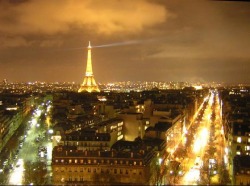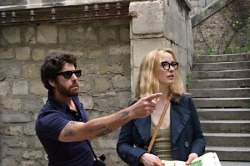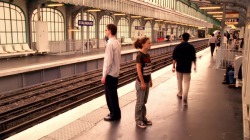City in Cinema: Paris

A city is the window into a culture’s history, mystery, and prospects. Europe is the land of film, film is the land of dreams, and Europe’s cities embody these dreams. Specifically, no city symbolizes a nation as surely as Paris does France. As the cultural and political capital of the nation, Paris has long held a privileged role in French cinema. Through the course of history, the filmic representations of Paris have reflected deep currents of national life (Krause 68). Whether the accounts of the bourgeois, the Battle of Algeria, or New Wave cinema, Paris seems to embody the rapid changes taking place around the country. In the 20th century, the sense of "Paris being a refuge place has been heightened by its intense ability to capture a sense of nostalgia and crisis," (Krause 72) while incorporating love stories and exceptional accounts of human complexity that transcend time. Both Paris je t’aime and 2 Days in Paris incorporate tales of love and relentlessly analytical emotionalism into the city of Paris and all it has to offer.
Paris je t’aime is the confabulation of eighteen short pieces into one narrative connected by human relationships. Young, old, black, white, Arab, French, American, British men and women come together in this epic film to create a fluid masterpiece exploring how one city can birth, nurture, develop, and complicate love stories. Strong romantic emotions stem from the subconscious or feelings beyond the bounds of reason, as well as deep revelations of hidden feelings in its many forms (Cowle et al. 131). The expression of these strengths of feeling becomes the loftiest way of bringing people to a deeper knowledge of the human condition and of human nature. Paris is portrayed by a specific kind of complexity characterized by cinema (Zants 55). While the physical size and population superficially typify a city, its complexity of historical and cultural change of movement in perception and affectivity serve to purely identify it as a place countless in opportunity.
In contrast, 2 Days in Paris follows the relationship between Marion, a whimsical French photographer, and Jack, a rigid French photographer. They have had a tumultuous trip to Europe, without much opportunity for romance. Relying upon Paris to rekindle their love and relationship, these two fail to use the city for their benefit. With witty banter and series of unfortunate circumstances, such as the tragic balloon picture, the film creates a comedic breakdown of the relationship. In the final scene, Marion finally realizes her phobia of commitment but resigns herself to Jack because she cannot stand to be alone again. This further demonstrates that Paris was the setting in which hope was expected but never attained. It is the place in which love can bloom but it must be a conscious effort, neither of which characterize Marion and Jack's relationship. Further demonstrating the role of the city in the development of relationship, 2 Days in Paris suggests that Paris is not only the city of love but the city of breakdown, of ripe love needing nurture to truly prosper.
There is a two-way relationship between city and cinema. Cinematic images comes out of urban experience, while incorporating such experience in a new aesthetic principle of movement where instability because the paradoxical principle of structure (Krause 85). This instability of cinematic images allows the city to be evoked in ways that stable images cannot. The city projects a specific kind of eroticism, where social relations with other are either changing or have broken down (Cowle et al. 150). It is the site of our encounter with the other, the site of irrational impulses and urging obsessions that take control of an individual (Laberge 292). By challenging the typical representation, the city mingles the surreal and inconceivable with the everyday, evoking an urban college and a cityscape that escapes our visual and conceptual grasps.
Both films evoke Paris and its ability to develop relationships, yet they both have distinct identities as films and differ in their conclusions about human love. Paris je t’aime is a positive, uplifting film about the potential for love, relationships, and conclusive to creating stories of tender human nature. The eighteen clips are each different but keep the same them throughout: true love is attainable and can be found with the right person, with the right efforts. In contrast, 2 Days in Paris is more of a negative, realist film concentrating on the bounds of love in Paris. It is about how we ultimately choose our life partners through apathy and possible resignation rather than genuine desire. While Marion can only see out of her peripheral vision, because of a birth defect, her boyfriend is a rigid American, strict in his view of the world. This film explores the way in which distances between people, genders, and cultures seem to shift constantly according to circumstances, exactly how Paris has shifted through history, according to revolutions, new social practices, and globalization. This film articulates that there are no absolute ideas and no fixed ideas.
Sources
Cowle, Peter and Edelmann, Pascal, ed. Projections: The European Film Academy
London: Faber and Faber, 2007.
Krause, Linda and Patrice Petro, eds. Global Cities: Cinema, Architecture and
Urbanism in a Digital Age. New Brunswick: Rutgers University Press, 2003.
Laberge, Yves. “Multiculturalism et transfert culturels: pour une histoire des mouvements
europeens au 20 siècle.” Annales canadiennes d’histoire 40(Aout 2005): 289-294 .
Temple, Micheal and Micheal Witt, ed. The French Cinema Book. London: The
British Film Institute, 2004.
Zants, Emily. Creative Encounters with French Films. New York: Mellen Research
University Press, 1993
London: Faber and Faber, 2007.
Krause, Linda and Patrice Petro, eds. Global Cities: Cinema, Architecture and
Urbanism in a Digital Age. New Brunswick: Rutgers University Press, 2003.
Laberge, Yves. “Multiculturalism et transfert culturels: pour une histoire des mouvements
europeens au 20 siècle.” Annales canadiennes d’histoire 40(Aout 2005): 289-294 .
Temple, Micheal and Micheal Witt, ed. The French Cinema Book. London: The
British Film Institute, 2004.
Zants, Emily. Creative Encounters with French Films. New York: Mellen Research
University Press, 1993
Article Cited
| multicultural.pdf | |
| File Size: | 944 kb |
| File Type: | |
Presentation Powerpoint
| city_cinemappt.pptx | |
| File Size: | 64 kb |
| File Type: | pptx |


